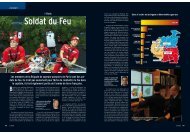Joint Publication 3-13, Information Operations - The Global ...
Joint Publication 3-13, Information Operations - The Global ...
Joint Publication 3-13, Information Operations - The Global ...
You also want an ePaper? Increase the reach of your titles
YUMPU automatically turns print PDFs into web optimized ePapers that Google loves.
Chapter I<br />
techniques include, but are not limited to, deception, electronic attack (EA), computer network attack<br />
(CNA), propaganda and psychological operations, and supporting signals intelligence (SIGINT)<br />
operations.<br />
h. With the free flow of information present in all theaters, such as television, phone, and Internet,<br />
conflicting messages can quickly emerge to defeat the intended effects. As a result, continuous<br />
synchronization and coordination between IO, public affairs (PA), public diplomacy (PD), and our allies<br />
is imperative, and will help ensure that information themes employed during operations involving neutral<br />
or friendly populations remain consistent.<br />
i. Legal Considerations in IO. IO may involve complex legal and policy issues requiring<br />
careful review. Beyond strict compliance with legalities, US military activities in the information<br />
environment as in the physical domains, are conducted as a matter of policy and societal values<br />
on a basis of respect for fundamental human rights. US forces, whether operating physically<br />
from bases or locations overseas or from within the boundaries of the US or elsewhere, are<br />
required by law and policy to act in accordance with US law and the law of armed conflict<br />
(LOAC).<br />
4. Principles of <strong>Information</strong> <strong>Operations</strong><br />
a. Success in military operations depends on collecting and integrating essential information<br />
while denying it to the adversary and other TAs. IO encompass planning, coordination, and<br />
synchronization of the employment of current capabilities to deliberately affect or defend the<br />
information environment to achieve the commander’s objectives. Figure I-3 describes how IO<br />
is integrated into joint operations.<br />
(1) Core capabilities (EW, CNO, PSYOP, MILDEC, and OPSEC) are integrated<br />
into the planning and execution of operations in the information environment.<br />
(2) Supporting IO capabilities (information assurance [IA], physical security, physical<br />
attack, counterintelligence [CI], and combat camera [COMCAM]) have military purposes other<br />
than IO but either operate in the information environment or have impact on the information<br />
environment.<br />
(3) Related IO capabilities (PA, civil-military operations [CMO], and defense support<br />
to public diplomacy [DSPD]) may be constrained by US policy or legal considerations. While<br />
these capabilities have common interfaces with IO, their primary purposes and rules make them<br />
separate and distinct. As a result, it is essential that commanders and their staffs coordinate their<br />
efforts when exercising their functions within the information environment.<br />
b. IO are primarily concerned with affecting decisions and decision-making processes,<br />
while at the same time defending friendly decision-making processes. Primary mechanisms<br />
used to affect the information environment include: influence, disruption, corruption, or usurpation.<br />
I-6<br />
JP 3-<strong>13</strong>



